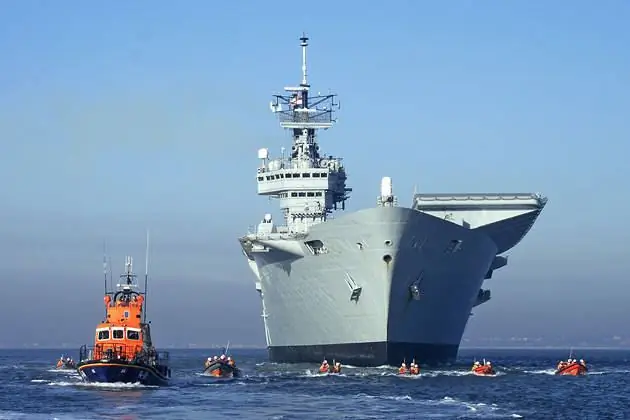- Author Matthew Elmers [email protected].
- Public 2023-12-16 21:49.
- Last modified 2025-01-24 09:17.

The growth of competition in the modern international market of naval equipment (VMT) is primarily associated with the beginning of the second "wave" of massive sales of used ships. This is due to the fact that today many states with powerful fleets are carrying out massive redundancies, given the lack of the need to maintain expensive ships to maintain when they are clearly not in demand. The huge number of offers on the market of used naval equipment shows a significant impact on the international market of new naval equipment.
Taking into account the number of sales in the secondary market, according to TSAMTO calculations, the size of world exports of naval equipment in 2011 will be about $ 6, 15 billion, in 2012 - $ 7, 3 billion, in 2013 - $ 8, 4 billion. In aggregate, according to the forecast of TSAMTO, the international market of naval equipment will track a "moderate" increase in the volume of sales, while a part of trade transactions in the secondary market of naval equipment will continuously increase in the total balance of international trade of naval equipment. The states of Southeast Asia and Latin America, as before, will remain in the center of activity in the sales market for ships already in service. At the same time, on the secondary market of naval equipment, offers will outstrip demand.
With regard to new ships, it must be emphasized that now every third newest army ship under construction in the world is initially prepared for export.
In contrast to the leading Western states, many progressing states continue to gradually build up their own naval capabilities. This is exclusively characteristic of the states of the Middle East, Asia and North Africa, where an increase in the purchase of BMC is expected.
In total, 5 main directions of the formation of the world market of naval equipment in the near future (until 2015) can be identified.
The first direction is connected with support ships. Currently, almost all states want to have the ability to quickly deploy their own armed forces in the conduct of territorial operations, which requires a huge number of ships of this type. This direction of the formation of naval technology is typical for a number of European and Asian states.
The second direction is connected with BNK OK and patrol and patrol ships and it can be considered especially actively progressing in the VMT market. In recent years, the demand for corvette-class ships with a displacement of 1000-3000 tons with ground-to-ground and ground-to-air strike missiles has increased.
The third direction is associated with an increase in the number of purchases of non-nuclear submarines. This is exclusively characteristic of the states of the Asian region.
The fourth direction is associated with the shift of emphasis in some countries of Africa, Asia and Latin America to the improvement of the coastal guard forces, and not to the modernization of the main composition of the ships.
The 5th direction provides for the leasing of transport and auxiliary vessels, as well as patrol boats due to the economical restrictions in almost all states on the purchase of ship stock.
The Netherlands plans to put up for sale two of its own Holland-class frigates. It is known that these are new ships under construction. Previously, they were intended to be transferred to their own Navy, however, in April this year, in connection with the government's decision to reduce the fleet, these ships will be offered to foreign customers.
Germany has put up for sale its 6 Type-206A class nuclear submarines from its own naval forces; according to preliminary data, Thailand will become a client of these nuclear submarines. On April 25, 2011, the Defense Council of this Asian state approved a program presented by the state's naval officials for the purchase of 6 Type-206A submarines from the German Navy for $ 257 million.
The Government of England published the Defense and Security Tactical Review in October 2010. According to this program, in March 2011 the aircraft carrier "Arc Royal" was withdrawn from the combat strength of the British fleet, which is currently put up for sale. This year, the British Navy plans to remove 4 URO frigates of the Type-22 plan: Cumberland, Chatham and Cornwall, which will be put up for sale to foreign customers.
The US Navy is no less energetic in the secondary market. One of the main "goods" is the sale of URO class frigates FFG-7 "Oliver Perry", landing ships, destroyers and minesweepers.
In addition, France, Denmark, Belgium, Spain, Italy and Portugal are huge players in the secondary market for naval equipment.






